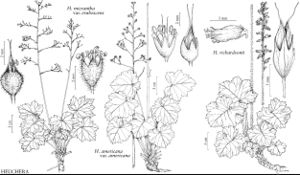Heuchera americana
Sp. Pl. 1: 226. 1753 ,.
Herbs acaulescent; caudex branched. Flowering stems leafy, 40–145 cm, glabrous or short stipitate-glandular. Leaves: petiole glabrous or very short to long stipitate-glandular; blade (often variegated adaxially), broadly ovate to cordate, shallowly 5–9-lobed, 3.5–11 cm, base cordate to nearly truncate, lobes rounded or ovate, margins dentate, apex acute or obtuse, surfaces abaxially glabrous or short stipitate-glandular, adaxially glabrous or short stipitate-glandular. Inflorescences diffuse. Flowers: hypanthium weakly bilaterally symmetric, free 0.6–2 mm, green, urceolate or campanulate, abruptly inflated distal to adnation to ovary, 3–7.2 mm, very short stipitate-glandular; sepals erect, green-tipped, equal, 1–2.4 mm, apex rounded; petals erect, greenish, white, pink, or purple, narrowly spatulate, unlobed, 0.9–4 mm, margins entire or finely dentate or fimbriate; stamens exserted 3–5 mm; styles exserted 2.6–6.4 mm, 4–7 mm, to 0.1 mm diam. Capsules ovoid, 4–10.5 mm, beaks divergent, not papillose. Seeds dark brown, ellipsoid, 0.6–0.9 mm.
Distribution

Ont., Ala., Ark., Conn., Del., Ga., Ill., Ind., Ky., La., Md., Mich., Miss., Mo., N.C., N.J., N.Y., Ohio, Okla., Pa., S.C., Tenn., Va., W.Va.
Discussion
Varieties 3 (3 in the flora).
Heuchera americana is highly polymorphic and distributed over a large part of the eastern United States and Canada. Its variability is largely the result of its wide geographic range, the sporadic, semi-isolated distribution of populations, and interaction of differential adaptation and genetic drift made possible by its distribution pattern.
Heuchera americana intergrades with both H. pubescens and H. richardsonii where they overlap; the intergrading form with H. pubescens is H. americana var. hispida, and with H. richardsonii it is H. americana var. hirsuticaulis. A breeding study between H. americana, H. pubescens, H. richardsonii, and other species demonstrated ease of artificial hybridization and fertility of offspring among H. americana, H. pubescens, and H. richardsonii (E. F. Wells 1979).
Individuals of the three varieties do not form intermixed populations; populations tend to be geographically isolated from one another and to be relatively uniform, displaying somewhat narrow character variation within a population.
The Cherokee Indians took Heuchera americana for dysentery and used the powdered root for malignant ulcers, bad sores, bowel complaints, piles, female problems, and sore mouth. The Chickasaw Indians used the root as an astringent and tonic (D. E. Moerman 1998).
Selected References
None.
Lower Taxa
Key
| 1 | Petioles densely long stipitate-glandular. | Heuchera americana var. hirsuticaulis |
| 1 | Petioles glabrous or short to sparsely long stipitate-glandular | > 2 |
| 2 | Petioles glabrous or very short to sparsely long stipitate-glandular; hypanthia free 0.6-1.5 mm; petals greenish, white, or pink, narrower than sepals, margins entire or finely dentate. | Heuchera americana var. americana |
| 2 | Petioles glabrous or very short stipitate-glandular; hypanthia free 1.5-2 mm; petals purple or pink, wider than sepals, margins fimbriate. | Heuchera americana var. hispida |
